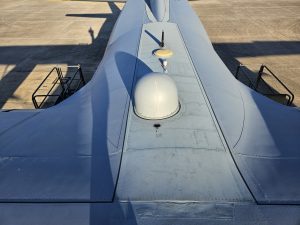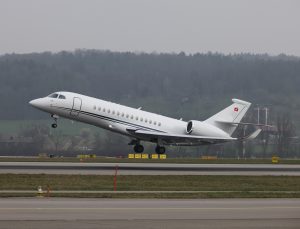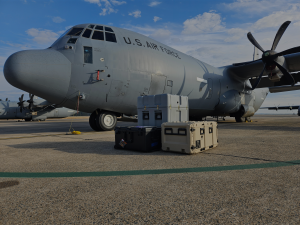For business travel, connectivity isn’t just important, it’s vital. Time spent in transit becomes time spent working when Wi-Fi internet access is strong and consistent. How does Satcom Direct make this happen?
We carefully plan every trip to ensure fast, secure, and reliable connectivity is available to all customers, regardless of aircraft type or mission needs by optimizing access to the increasing number of satellite companies providing Ka- Ku- and L-band services.
But what are “bands” and why should the typical executive ready to jump on a conference call care about them? Modern satellites operate in specific areas, or bands of the electromagnetic spectrum. Each has a frequency range that influences multiple communication factors, including the quality of the connection, the data-transfer rate, resilience to interference, bandwidth and, of course, cost. The primary ones we resell on behalf of our airtime partners at Satcom Direct are Ka, Ku, and L; each has its advantages. (The L-band, for example, is less impacted by weather than other bands.)
The professional wishing to join Zoom (or stream a movie) doesn’t have to know, or care, which band is being used because Satcom Direct tailors every connectivity package to the specific needs of each owner, aircraft, and mission profiles.
“We offer connectivity solutions in all the different bands because there’s no one-size-fits-all approach,” said Robert Vega, Senior Director of Product Management for SD. “Depending on the type of aircraft, the flight path, budget, and the types of applications the travelers will utilize, we’ll determine which band solution is the best fit. The conversation starts and ends with what we’re trying to accomplish on behalf of the client. That’s what determines the services, and effectively the bands, to be used.”
The satellite network services we offer in our customer-centric approach include:
Inmarsat Jet ConneX: a global Ka-band network, Jet ConneX is one of the most widely utilized high speed services in business aviation. Inmarsat is the owner/operator of the world’s only global Ka-band satellite network. The upshot? Advanced capabilities to support all types of online activities.
Inmarsat SwiftBroadband: this L-band network enables key cockpit and cabin applications, offering reliable in-flight voice and data connectivity—regardless of the type of aircraft being flown.
Intelsat FlexExec: a Ku-band network, it’s designed specifically for the unique requirements of business jets. This premium satellite network provides global, high-speed connectivity with many flexible plan selections.
Iridium Certus®: this L-band network powered by the NEXT satellite constellation, offers pole-to-pole global voice and data coverage. Its constellation of satellites is also cross-linked to provide weather-resilient connections worldwide. We support single- and multiple-channel Iridium transceivers.
Viasat: this offers dual-band solutions for business. Its airborne terminals allow aircraft to roam across both Ka-band and Ku-band networks.
*****
To further explain SD’s approach to ensuring seamless in-flight connectivity, Vega offers two examples: “Consider a brand-new Gulfstream G700 aircraft coming right off the line; it may have a Ka terminal already installed. The customer who purchases this plane generally plans to fly all over the world with multiple people onboard using the internet at the same time. In that case, an Inmarsat Jet ConneX Ka-band solution would be a great option as it’s proven for that aircraft.
“But say you’ve got an in-service aircraft with global capabilities, but no high-speed data system, just a Ku antenna. Perhaps the flight department budgets per flight hour. You still want to go anywhere and utilize the internet, but the aircraft is optimized for a Ku system. The Intelsat FlexExec service might be the best choice because it’s better geared toward the aircraft, and we support flexible payment plans to meet the varying customer needs.”
Satcom Direct, which has been advancing the technology of connectivity since 1997, does more than seek out the best existing solutions. It also creates new ones. “We are developing our own terminals specifically designed for business aviation,” Vega said. “Some of the aircraft can be quite small, so we’re creating terminals that optimize the internal and external space available on a business jet without sacrificing performance. These antennas will allow us to tap into those Ku- and Ka-band satellite constellations to provide the best experience possible.
“By developing our own systems, we have visibility into the connectivity performance as we monitor the behavior of the hardware on the aircraft, the service of the satellite and everything else that’s operating on that aircraft,” he explained. Such visibility is one of the reasons Satcom Direct proactively monitors any in-flight connectivity issues and can provide speedy remedial actions. “This is the benefit of a single resource providing an end-to-end solution. It takes one call for connectivity acquisition and all subsequent support.”
It’s hard to grasp the dramatic advances made in satellite communication since Telstar 1’s 1962 launch to determine “the feasibility of transmitting information via satellite.” However, thanks to companies like Satcom Direct, advancement shows no sign of slowing down. “As more satellites are launched, and we develop better hardware, software and support, we’ll continue to improve in-flight connectivity with the very best customized, fully-integrated solutions,” Vega said.
Want to learn more? Contact us today to discover how your organization can benefit from connectivity experts with a passion for quality customer service.


